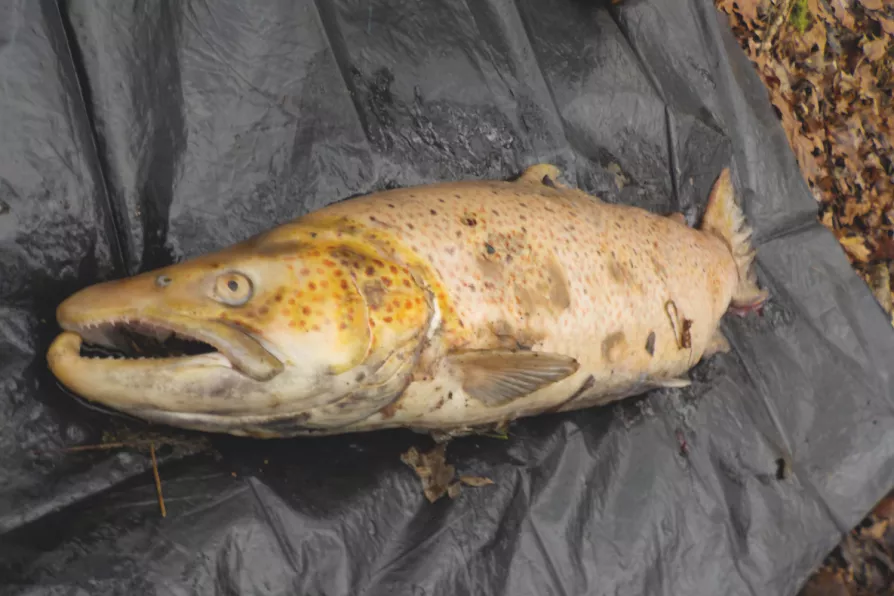The long-term effects of chemical weapons such as Agent Orange mean that the impact of war lasts well beyond a ceasefire

 ‘THE GREAT BEAST’: His hooked lower jaw (a ’kype) is a weapon for warding off other courting males
‘THE GREAT BEAST’: His hooked lower jaw (a ’kype) is a weapon for warding off other courting males
AT Christmas, as well as all the usual stuff, I look forward to seeking out some companions whose presence in my countryside was unsuspected by me for most of my life.
They are great heavy beasts, streamlined, two feet long and more, with broad, muscled backs speckled red and black. Far too large to be overlooked, surely?
Miss them I did, though, despite having wandered those fields and wooded streams since childhood.
One lucky Christmas Eve I made my way in deepest dusk along the bank of a shallow, fast-running gravelly stream with trees bent over. Right by my feet I heard a loud “swoosh” and saw the water swirl and cloud.
Then I spotted a great sea trout stationary in a little gravel gully about two paces from me, gently waving its body to maintain its position. Its rear half was reddish-orange. Its back was olive-fawn. Its tail and back fin were dark. It changed position, exposing its back above the shallow water as it moved into a nearby gravel “scrape” alongside a second, smaller trout.
I watched them side by side in their courting bed for a long time, before I moved silently and slowly away.
I felt as privileged and euphoric as those shepherds must have done in the old crib story.
I’ve since seen them or their cousins in those spawning nests — “redds” — again and again on Christmas Eve and close to, and always it has felt like ancient magic. Midwinter magic.
These Sussex sea trout have been returning to their Wealden streams since the Ice Age. Like the salmon, they are cold-water fish, needing these clean, fast, oxygenated streams for spawning.
Anglers who read these notes may be surprised at me calling these Sussex sea trout “great beasts,” yet they are larger than many salmon, and have the highest average weight of any sea trout population in the British Isles.
We do not expect such size in sea trout of soft southern landscapes. Yet you have to go north as far as the River Esk at Whitby to find others of comparable size. The Sussex strain spawns over a month later than other sea trout populations, too. It isn’t a Christmas thing elsewhere.
Sea trout are the same species as brown trout. They just choose different life strategies. Brown trout (“brownies”) stay at home, grow more slowly on smaller food supplies, and mostly (but not always) stay small.
Sea trout leave their birth streams at the end of their youth and travel to the sea for most of their adult life, returning after a few months or years to their streams to spawn.
They grow heavy, with deep, long bodies, on the far richer marine food sources. The Sussex giants perhaps feed across the North Sea, off the German coast.
Later in the same year that I first saw these beasts in numbers, a staff member at the agricultural college which lies close to the main Sussex sea trout spawning stream spread a silo full of cattle slurry over the winter fields around the streams.
The rain came — and washed this foul-smelling muck into the streams, where it killed all that it met. Sea trout, brown trout, minnows, bullhead, brook lamprey, stone loach, all floated belly-up and dead as the muck flowed on.
Tireless workers from Southern Water (itself notorious for its many sewage-releasing disasters) worked day and night to halt the flow before it reached the main river. Heroically, they succeeded.
Yet the damage was done.
After that disaster, the sea trout numbers in that stream crashed. I’ve never re-found stone loach there, and brook lamprey appears gone. Only over the last three years do trout numbers appear to be recovering, and we’ve again found low numbers of dead “kelts,” the too-weak, exhausted, post-spawning sea trout who died before they could make their way back to the sea.
It doesn’t look good. Global warming looks like rendering the spring-spawning grayling — another cold-water salmonid — extinct in a number of its southern rivers. Salmon are extinct on our main Sussex sea trout river.
They’ve been gone since the 1970s, perhaps much earlier, as breeders. Proposed new housing developments compound the threats from water extraction and pollution. Brown algae coats the gravel in even the cleanest streams.
Now, a new and awful existential threat has arrived. Our main Sussex sea trout river has no bank public access for miles, yet when free walking it during Covid I discovered a population of the Asiatic clam, Corbicula fluminea.
This horribly invasive bivalve can wipe out most other freshwater life, to reach over 90 per cent of river biomass. It is now known to be present over miles of our river. In the Fens, it has already choked several of the main rivers and is now in all of the main river catchments of the Norfolk Broads.
Is our “great beast,” which Neanderthal and other Ice Age early humans fished, finally reaching the end of its long, long Christmas journeyings?
Great Beast: On finding the corpse of a giant cock sea trout kelt
We tracked the stream’s edge through blackthorn brake and by muddy path,
Teetering on high banks, leaping the mudslides where deer slots reveal their night-time fordings.

ANDY CROFT welcomes the publication of an anthology of recent poems published by the Morning Star, and hopes it becomes an annual event

JAN WOOLF examines work that aims to give viewers a material experience of the environments in the polar north and Britain equally affected by the climate crisis

One of the major criticisms of China’s breakneck development in recent decades has been the impact on nature — returning after 15 years away, BEN CHACKO assessed whether the government’s recent turn to environmentalism has yielded results

MATT KERR charts his bike-riding odyssey in aid of the Royal Marsden charity and CWU Humanitarian Aid










